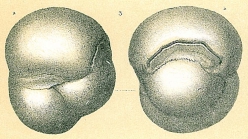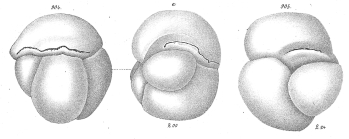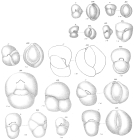Deep-Sea taxon details
Planispirinoides Parr, 1950
marine, brackish, fresh, terrestrial
Parr, W. J. (1950). Foraminifera. <em>B.A.N.Z. Antarctic Research Expedition 1929-1931. Report.</em> Series B 5 (6): 232-392. [details] Available for editors 
Type locality contained in Antarctic Ocean
type locality contained in Antarctic Ocean [details]
Hayward, B.W.; Le Coze, F.; Vachard, D.; Gross, O. (2025). World Foraminifera Database. Planispirinoides Parr, 1950. Accessed through: Glover, A.G.; Higgs, N.; Horton, T. (2025) World Register of Deep-Sea species (WoRDSS) at: https://www.marinespecies.org/Deepsea/aphia.php?p=taxdetails&id=112033 on 2025-05-17
Glover, A.G.; Higgs, N.; Horton, T. (2025). World Register of Deep-Sea species (WoRDSS). Planispirinoides Parr, 1950. Accessed at: https://marinespecies.org/deepsea/aphia.php?p=taxdetails&id=112033 on 2025-05-17
Date
action
by
2006-09-27 07:06:07Z
changed
Martinez, Olga
original description
Parr, W. J. (1950). Foraminifera. <em>B.A.N.Z. Antarctic Research Expedition 1929-1931. Report.</em> Series B 5 (6): 232-392. [details] Available for editors 
basis of record Gross, O. (2001). Foraminifera, <B><I>in</I></B>: Costello, M.J. <i>et al.</i> (Ed.) (2001). <i>European register of marine species: a check-list of the marine species in Europe and a bibliography of guides to their identification. Collection Patrimoines Naturels,</i> 50: pp. 60-75 (look up in IMIS) [details]
additional source Neave, Sheffield Airey. (1939-1996). Nomenclator Zoologicus vol. 1-10 Online. <em>[Online Nomenclator Zoologicus at Checklistbank. Ubio link has gone].</em> , available online at https://www.checklistbank.org/dataset/126539/about [details]
additional source Loeblich, A. R.; Tappan, H. (1987). Foraminiferal Genera and their Classification. Van Nostrand Reinhold Company, New York. 970pp., available online at https://books.google.pt/books?id=n_BqCQAAQBAJ [details] Available for editors
basis of record Gross, O. (2001). Foraminifera, <B><I>in</I></B>: Costello, M.J. <i>et al.</i> (Ed.) (2001). <i>European register of marine species: a check-list of the marine species in Europe and a bibliography of guides to their identification. Collection Patrimoines Naturels,</i> 50: pp. 60-75 (look up in IMIS) [details]
additional source Neave, Sheffield Airey. (1939-1996). Nomenclator Zoologicus vol. 1-10 Online. <em>[Online Nomenclator Zoologicus at Checklistbank. Ubio link has gone].</em> , available online at https://www.checklistbank.org/dataset/126539/about [details]
additional source Loeblich, A. R.; Tappan, H. (1987). Foraminiferal Genera and their Classification. Van Nostrand Reinhold Company, New York. 970pp., available online at https://books.google.pt/books?id=n_BqCQAAQBAJ [details] Available for editors
 Present
Present  Inaccurate
Inaccurate  Introduced: alien
Introduced: alien  Containing type locality
Containing type locality
From editor or global species database
Diagnosis Test subglobular, proloculus followed by cornuspirine stage with planispiral undivided tubular second chamber, later chambers onehalf coil in length, triloculine, the planes of coiling being perpendicular to that of the earlier stage; wall calcareous, imperforate, porcelaneous, surface smooth; aperture an elongate slit near the base of the final chamber, with a broad flaplike tooth occupying the lower rim. Holocene; Atlantic; Antarctic; Australia; S. Indian Ocean: Kerguelen Island. (Loeblich & Tappan, 1987, Foraminiferal Genera and Their Classification) [details]












